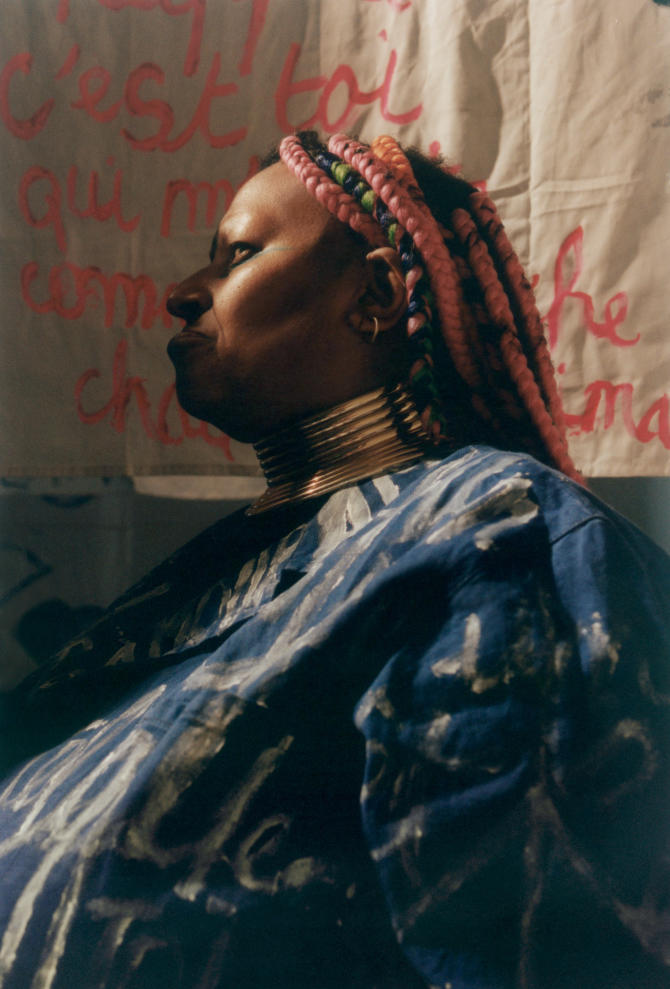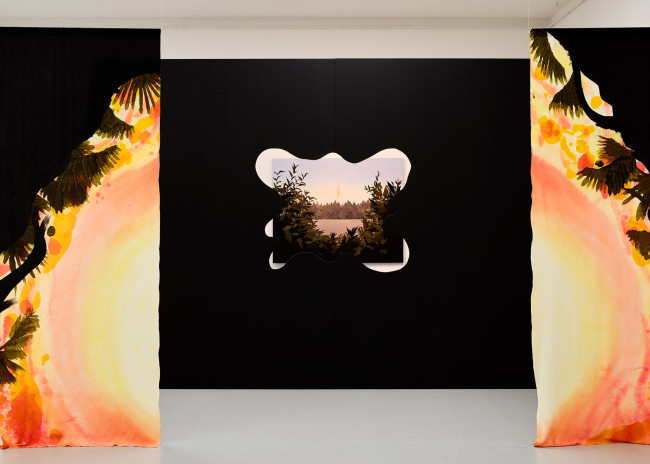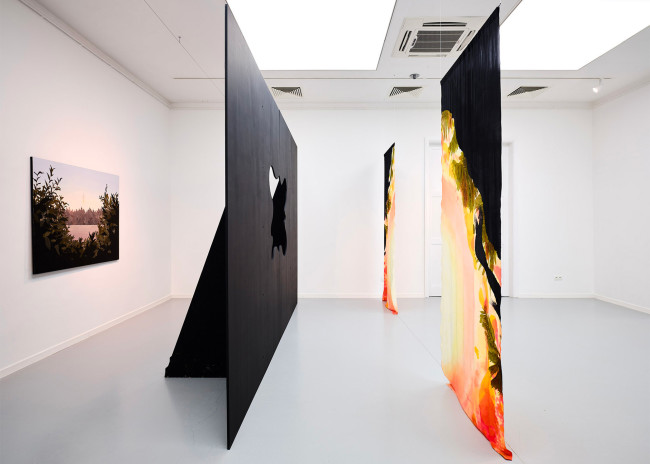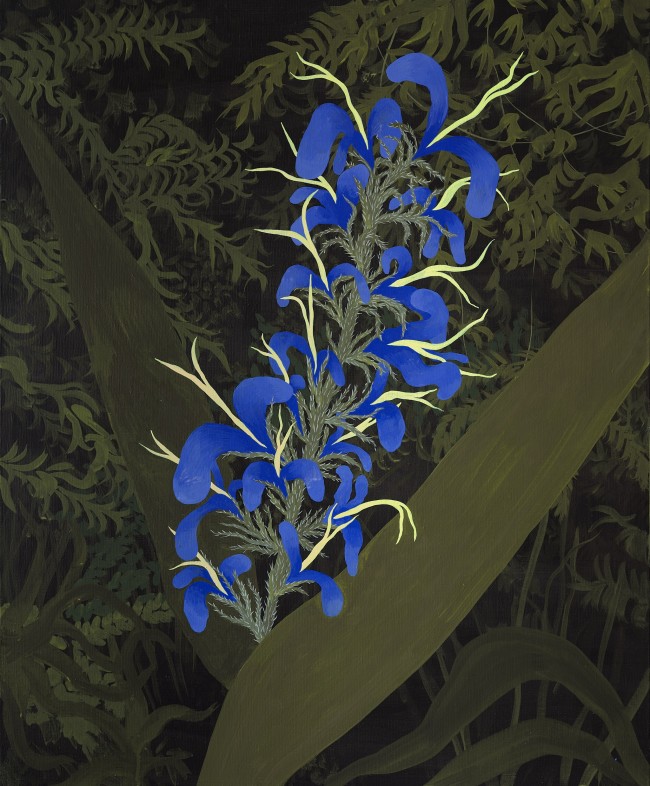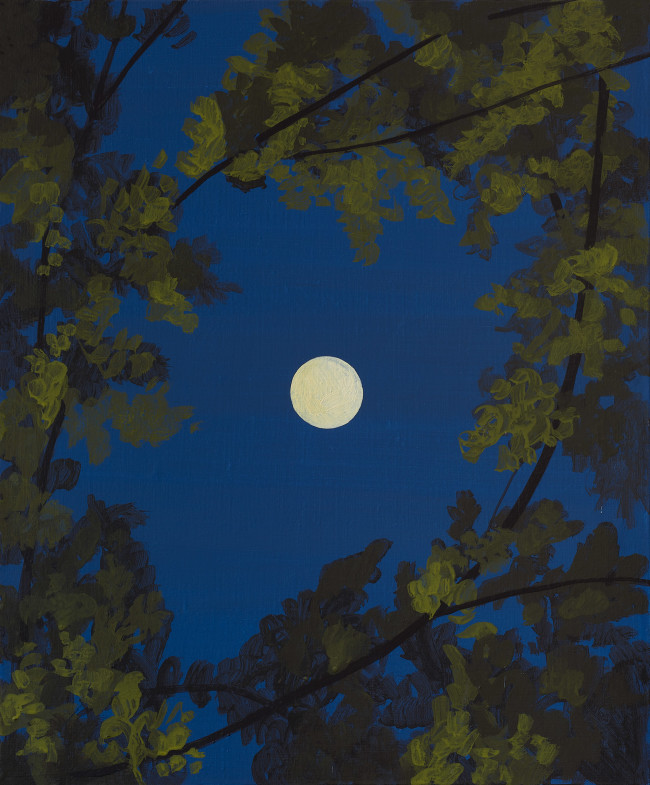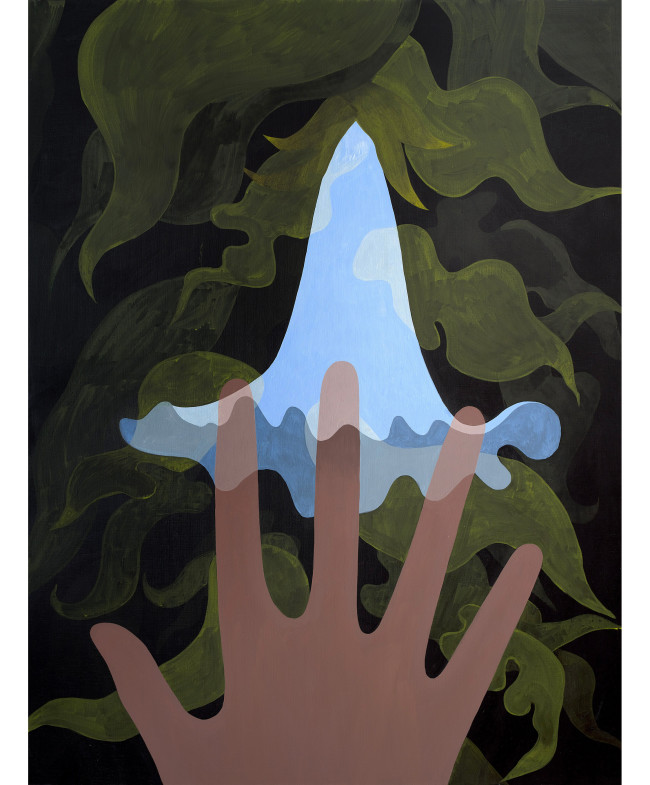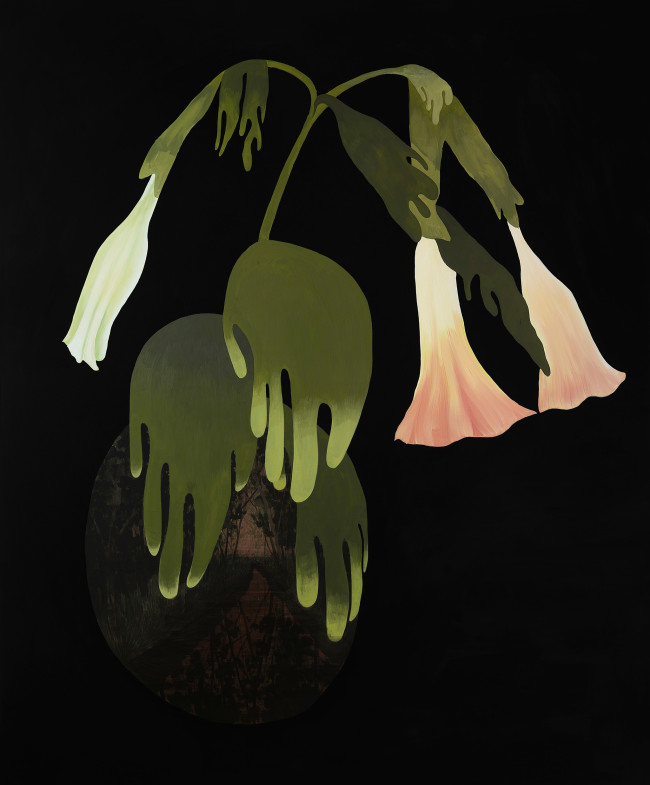Magdalena Karpińska

Text: Maja von Horn
Photography: Gosia Turczyńska
We meet in the artist’s studio in Warsaw’s Stare Bielany neighbourhood. Despite the freezing December day, the large windows of the renovated 1930s building let in a beautiful afternoon light. “I need a clear environment to work. We don’t get a lot of natural light in the winter, but artificial lighting is actually clean. Mixed light is the worst kind, followed closely by reflected light, like that reflected off of leaves. Any kind of distraction in your lighting is undesirable,” Magda says. She works largely using egg tempera, a traditional and time-consuming technique popular before the advent of oil painting. Instead of using ready-made paint, the artist mixes egg yolks with pigment in a mortar.
“This technique best reflects my philosophy of colour. It lets me achieve a depth that I can’t get using ready-made paint,” she says, putting her canvases against the window. “See? The colors change with the light. They don’t reflect it, they absorb it.”
Maja von Horn: You said that you’d be a painter from a very early age. Where did you find the conviction that your childhood dreams could become a career?
Magdalena Karpińska: I never had that conviction, but painting has always been a big passion of mine. It took a long time for it to even cross my mind that I might not be able to make it my life path, because I never associated art with success – or the lack of it. I simply painted. I was raised to think that art is important.
M.V.H.: Did you have any artists in the family?
M.K.: Not fine artists, no. My father has a degree in art history, but he’s always been involved with film, theatre, and literature. Our parents often took me and my sister [author Maria Karpińska] to museums, we did a lot of sightseeing. It was a wonderful way to grow up, filled with interesting conversations. Everyone always supported my drive to become a painter, because I never really did anything else. I would draw during all my classes at school, in every notebook. My parents would get notes from my teachers that their daughter is not paying attention because she’s always drawing. Once, I drew all over my maths notebook, and the teacher went ballistic.
M.V.H.: Your work often features botanical motifs. Is this an influence of the place where you grew up?
M.K.: I grew up in a house with a garden built by my great-grandfather in Warsaw’s Żoliborz neighbourhood. The house is surrounded by a park. Images from all the time spent in the park and the view from the house’s window were imprinted in my mind at a very early stage of my development and became encoded in my subconscious. But I was directly influenced by a garden that surrounds a house about 40 km from Warsaw that has been in my family for generations. It was first meticulously designed in the French style (and partially English) and then all that was so neatly trimmed got taken over by nature. I spent a lot of time there in the years after graduating from university. I was at the threshold of adulthood, in the process of developing my own identity and confronting the first losses of my life – my grandparents’ deaths. Observing the nature there, much of which is nearly primordial, during such a formative time for me, became a major inspiration. I felt a great need to be painting nature. And thus, in a very organic way my first series of paintings came to be. They weren’t just youthful experimentation, but a mature collection that I wanted to exhibit. I had my debut show in the now-defunct Galeria Czarna in 2011.
M.V.H.: Nature became a leading motif in most of your work.
M.K.: At a certain point I realised that through painting nature I can say the most. Nature is more powerful than us.That’s the way it’s always been and always will be. It’s a constant, which is why I think it’s a good conduit to talk about fear and anxiety. It has a soothing, calming effect, but it’s also terrifying how small we are in comparison. In the face of climate change, nature becomes a very meaningful motif to use in painting. The nature that I paint can soothe, but it can also elicit dread, uneasiness, and respect. I don’t have botanical knowledge, I’m not observing nature from the position of an expert, but from one of a fascinated and sometimes terrified observer. Painting nature is painting about the entirety of life and about the human experience. I think a lot about the absurd nature of life and the absurd nature of reality, and you can see traces of these ruminations in my paintings. There are days when the thought that the world is more and more absurd is terrifying, and there are days when it is reassuring. If I saw frogs raining outside my window, I wouldn’t be too surprised. Every absurdity has an explanation.
M.V.H.: Nature often permeates the erotic in your work.
M.K.: Painting is the most sensual medium of them all, and the substance, the corporeality of the canvas are very important to me. In my work landscape, nature often permeates the body, the erotic, and the other way around. Leaves often resemble hands, flowers have tongues. I painted a triptych that is my own personal interpretation of Penelope’s story in The Odyssey. In my version, Penelope realizes she doesn’t have to wait for Odysseus, but embarks on her own journey – one that’s within, that’s internal. A journey of personal development, of erotic self-learning. The entire triptych is a reflection on forgoing a sea journey in favor of internal development.


M.V.H.: Let’s return to your university days. You graduated from the painting department at the [very selective] Academy of Fine Arts in Warsaw, where you were accepted on your first try, right after high school. But you say that your thesis work, which you got the highest marks for, is weak and childish. How do you know a painting is weak?
M.K.: Generally speaking, the painting either works or it doesn’t. I was one of the youngest people in my class. In hindsight, I think what I did as part of my thesis work was immature. Not in terms of age, because that really depends on the person, but artistically. I was painting very disparate things, the thesis was a chaotic collection of paintings without any sort of cohesion, theme. There was no specific artistic statement. Technically they were also quite average, it was all pretty uninteresting.
M.V.H.: In that case, what did studying at the Academy of Fine Arts give you as an artist?
M.K.: The Academy provides excellent opportunities to learn different techniques – you have access to a special wall art studio, where you can learn fresco or mosaic techniques, or to a textiles studio, where you can learn how to paint on different surfaces. You have access to an enormous amount of knowledge that is hard to find in a textbook. The Academy also gave me its fantastic art history department, and its people – my fellow students, amazing artists that I’m still in touch with. You can learn technique at the Academy, but you can’t learn art – for that, experience is indispensable.
M.V.H.: What do you like so much about egg tempera?
M.K.: I pick the technique according to the needs of the piece, depending on how I want to talk about a given topic. With tempera, you build the painting with layers, starting with opaque ones and gradually going more and more semi-transparent. You can’t put on more than two layers a day, since the painting will start cracking. I grind dry pigments with egg yolk to make the paint, so it can only remain fresh for a day or two. After that it gets spoiled and you have to pour it out. This is why you have to very systematically plan out your egg tempera painting. A piece painted with tempera has depth, it changes depending on the lighting. Black will never remain just the dull black that’s been squeezed out of a tube – because it is created with different pigments, it will transform when lit. You can also achieve beautiful cool blues, which you cannot do with oil paint, because oil yellows, always giving it a slight element of warmth.
M.V.H.: If each painting is built with multiple layers, and you can only layer two coats s a day, how long does it take to paint using egg tempera?
M.K.: I usually need about a month for one painting, but I’m always working on several at a time. When one is drying, I’m painting another one. Since they are usually born out of one train of thought, these pieces are often in dialogue with each other and organically form a series. If I feel like I’m missing something in a given painting, I fulfil that need on another canvas, and then I put them together.
M.V.H.: You paint not only on canvass, but also on textiles, most often on silk.
M.K.: It’s kind of a complement to my work on canvas. At a certain point I felt the need to leave the flat surface and go into the third dimension. So I started to paint on silk, which has a sculptural element to it. I install them in a space, often in movement. Sometimes I connect them with other elements, like canvas paintings or carpentry. This kind of installation reflects the layered nature of working in tempera, bringing it into the third dimension. Painting on fabric gives me space to breathe, more so than I get with the very precise canvas painting. It allows for spontaneous expression, which tempera painting doesn’t leave much room for. I lay out the silk on the floor and I paint while walking on it. It’s very sensual work.
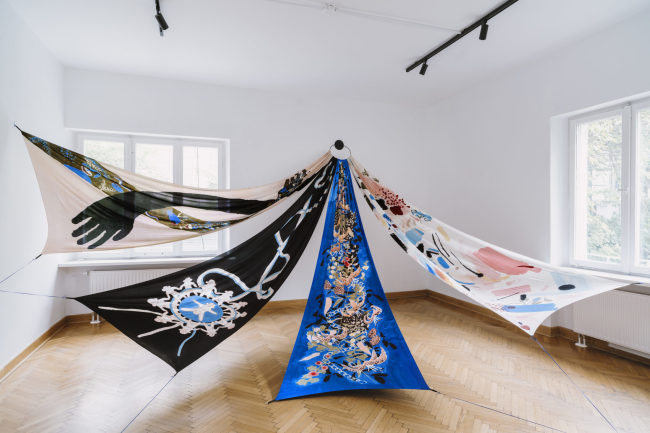
M.V.H.: For the collective “Wonder Woman” show during Warsaw Gallery Weekend in 2018 you created a silk cape with the same title.
M.K.: The cape was constructed from four large strips of painted silk, with each one speaking to the strength of women in a different way. The man who created Wonder Woman [William Moulton Marston] was a scientist in a polyamorous relationship with two women, also scientists. They inspired him to create the character. When he died, the women stayed in a romantic relationship and spent the rest of their life together. A friend told me this story, and I decided to honour female friendship by talking about her in one of the “Wonder Woman” cape strips. The second strip refers to flowers and chains, which were popular motifs on silk scarves when I was a child. The third is inspired by a sculpture from the first century BCE from Mexican Nayarit culture which I saw at a ceramics museum in Faenza in Italy. I was very moved by this sculpture, which shows a mother giving birth while surrounded by a circle of other women – a timeless symbol of female support. The fourth strip I used for testing and wiping my brushes while painting the other three. I decided to add it to the cape as a sort of reverse of the entire thing. With this piece I wanted to honour all women, because I feel the power of sisterhood nearly every day.

M.V.H.: What advice would you give to artists looking for a creative path?
M.K.: To trust yourself. It sounds so easy, but it’s very difficult to implement in practice. I think that every young artist deals with uncertainty, with other people’s opinions, with other obstacles. You have to find your truth, the answer to what you want to do on your own. Truth will always prevail, but you can’t accelerate the process. It comes sooner to some, later to others. It’s definitely easier if we’re not alone in this difficult period. I am lucky to have been born to a family in which art was at the top of the hierarchy of everything that’s important. I remember when in a moment of doubt, my father read me a poem by Cavafy about how hard the creative path is in life. I am still moved when I think about it.

Magdalena’s Favorite Places in Warsaw
- Polana Institute – gallery that I work with along with a wonderful group of artists that organises every show in a different, interesting space in Warsaw.
- Piekarnia Dej – the best bread in Bielany, a worthy pistachio cornetto, and in the summer delicious ice cream made from real cream, with a little ginger. The only flaw of this place is the frequent lines. But I’m not surprised by them.
- Na Temat Piękna – a day spa in a 1930s building. You can really rest here, in the garden as well. You can feel like you’re on vacation.
- Restauracja Reiwa – seasonal menu, food that causes me sleepless nights, because I suddenly get the urge to eat it.
- Crush – the best vintage boutique in town. It was born out of these gatherings of women that I participated in and whose atmosphere you can still sense there today.
- Najlepsza Księgarnia - the best bookstore, literally
- Park Fosa – the park of my childhood.
- TartaTa Cafe - delicious french pastries made with great attention to every ingredient and detail, which you can taste in each bite.
